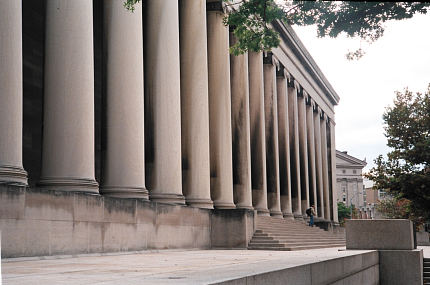
The columns of the Mellon Institute are supposedly the largest monolithic columns in the world. For scale, note, if you can make him out, the man with the backpack walking down the steps.

Late-afternoon sun glows on the main entrance to the Carnegie Library in Oakland. Andrew Carnegie, who thought it was a scandal to die rich, attributed his own success to the access he had as a child to a kindly gentleman’s library. There are still Carnegie Libraries in towns and cities all over the United States, but this is the greatest of them all.
Somehow Charles Z. Klauder managed to create perfectly Gothic buildings with an Art Deco sensibility in every detail. His Cathedral of Learning is the most perfect Gothic skyscraper in the world; it’s organically Gothic, not just a skyscraper with Gothic trimmings.
On the same ideally landscaped square in Oakland sits Heinz Chapel, Klauder’s last work, a building with more modest dimensions but more flamboyant ornament. Its lacy spire is a remarkable work of Gothic fantasy. Its transept windows, designed (like all the other stained glass in the building) by Charles J. Connick, are supposedly the tallest stained-glass windows in the world, or among the tallest, or rather tallish, depending on which source you consult. It’s one of Pittsburgh’s favorite wedding sites, and on a Saturday afternoon weddings follow one after another as though the brides were on a conveyor belt.
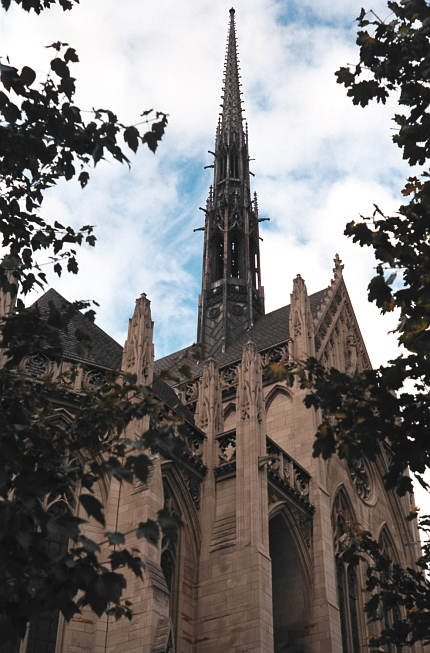

The cornerstone identifies the date in figures that perfectly match the Deco Gothic spirit of the building.
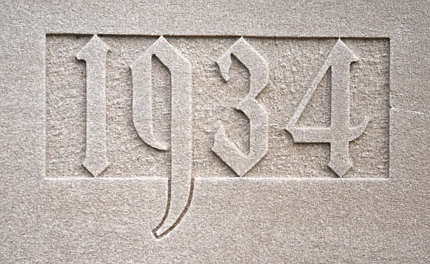
These photographs were taken with a Zorki-4 bearing a Jupiter-8 f/2 lens, which is a fine camera for a day out in the city. It’s versatile, it’s built like a Soviet tank, and the lens is sharp and fast (and interchangeable with any screwmount Leica lens). And there were literally millions made, so if it does break you can just get another one.
Update: The Highland Building has been expensively restored and looks beautiful.
The Highland Building is East Liberty’s only proper skyscraper. One cannot apply such a romantic name to the Stalinist housing blocks built all over the East End to warehouse the poor in the 1960s—excrescences that are now being blown to bits one by one, and high time, too.
Designed by Daniel Burnham, the Highland Building uses the classic base-shaft-cap formula that always produces a balanced-looking building. It’s a national treasure, for the simple but sufficient reason that every building by the great Burnham is a national treasure. Pittsburgh is blessed with a larger number of Burnham buildings than any city outside his home of Chicago, and most of them are treated with the respect they deserve. This one, however, is not.
This picture of the Highland Building was taken years ago and found on an old archival disc:

The thing has sat vacant for years, prey to vandals and vermin. But that’s about to change. According to the Post-Gazette, the Highland Building will see new life as a hotel. It’s too early to celebrate: deals can fall through, money can dry up, and projects can always be abandoned. But it looks as though one of our most undeservedly neglected buildings may have found a new life at last.
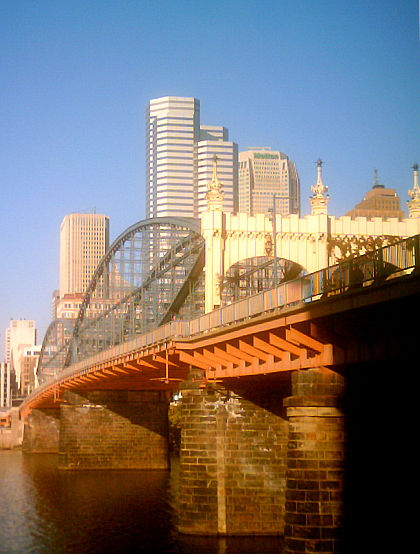
Two pictures of the Smithfield Street Bridge, both taken with the same toy digital camera.
Lenticular or “scissors” trusses (sometimes called “Pauli trusses”) are rare on bridges anywhere. This is one of the great examples in the United States. The bridge was designed by one of the great names in bridge-building, Gustav Lindenthal. Until the 1980s, the dowstream side carried automobiles and the upstream side streetcars, but the streetcars were rerouted over the Panhandle Bridge when the subway downtown opened. After a major restoration, the bridge now caries automotive traffic on both sides.
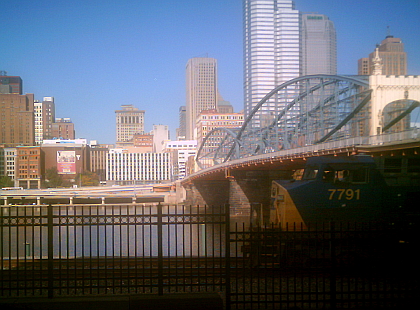
If you are a bridge lover, Pittsburgh is the one city you must see before you die. There are more bridges here than in any other city anywhere, and for a considerable time there was actually a government body here charged with seeing that new bridges were not only practical and safe, but aesthetically beautiful as well. An excellent introduction to the bridges of Pittsburgh is at pghbridges.com.
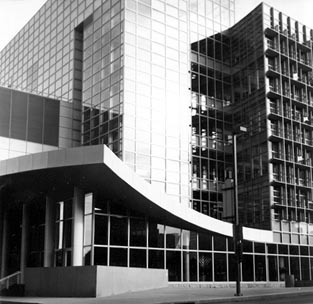
The Alcoa headquarters on the North Shore, which one might describe as a modernist-revival building.

A night view of the Software Engineering Institute in Oakland. Look closely for the interesting reflections of St. Paul’s in the windows.
Beginning photographers are often advised to buy the most expensive tripod they can afford. The opposite might be better advice. If you wait until you can afford an expensive tripod, you may never buy the tripod. A twenty-dollar tripod may be a bit flimsy and unreliable, but it makes pictures possible that were not possible before. No amount of money spent on a better tripod will increase a photographer’s capabilities as much as that first twenty dollars. This picture was taken with a forty-dollar Russian Lubitel twin-lens reflex camera supported by a twenty-dollar tripod.
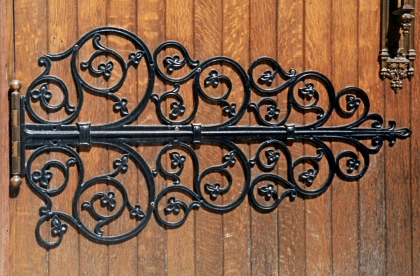
One of the hinges on the great wooden doors of St. Paul’s Cathedral in Oakland.
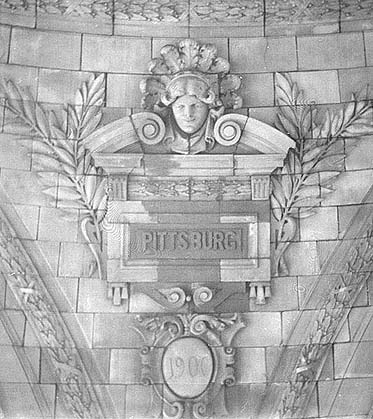
For a few years around the turn of the twentieth century, Pittsburgh was most commonly spelled without the H, on account of a ruling by the Post Office that all burgs should be so spelled. The spelling had never been completely standardized, but the spelling with the H was always the popular favorite, and the Post Office soon relented. Some pedants still insisted on the other spelling, however, and the Pittsburg Press daily was so spelled into the 1930s. Here the name appears as one of the four corners of the earth under the rotunda of the Pennsylvania Station.

Father Pitt thinks the Westinghouse Memorial in Schenley Park is the most effective memorial in Pittsburgh. Instead of a heroic statue of the great inventor George Westinghouse, what we see is a boy, representing the youth of the future, learning about Westinghouse’s accomplishments. Because of Westinghouse, we have safe high-speed travel and electricity in our homes, and many other astonishing things we take for granted today. Thousands of Westinghouse employees, who remembered the founder fondly, donated their own money to keep his memory alive. These pictures, which show only a small part of the memorial, were taken with a Kodak Tourist camera, a simple and very common folding camera that, like many other Kodak cameras of the time, has good optics and a reliable mechanism.
